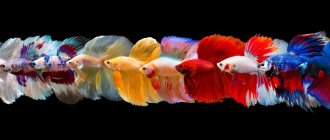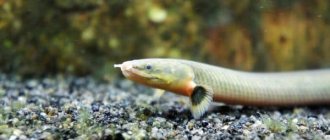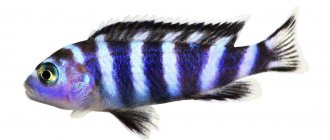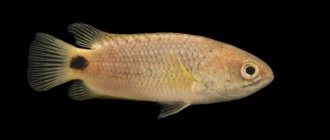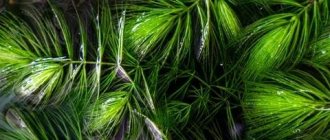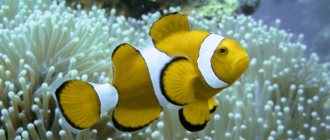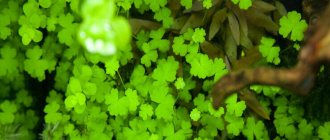It’s worth noting right away that tiger astronotus is not for everyone. Quite beautiful aquarium fish that understand who is the owner, can allow themselves to be stroked and can even eat from their hands (however, it is better to be careful here, because they can bite) - a real domestic aquatic animal. It reaches large sizes and therefore requires large aquariums, however, it is not a very fastidious cichlid. Appreciating their beauty, the ichthyofauna made the astronotus (Astronotus ocellatus) a real aquarium resident!
Description
Astronotus oscar (this is another name for it) is represented by a large number of color forms (for example, red, white). In nature, it lives in the waters of South America. Their coloring is not so bright; they usually have a dark shade with orange spots on the back and gills. Near the caudal fin there is a black spot with an orange edging; due to this “extra eye,” the ocellated astronotus is also called.
An interesting feature of Oscars is that artificially bred domestic forms change their color when stressed, fighting or defending territory.
In aquariums it grows up to 25 cm, in nature up to 35 cm. Moreover, they grow quite quickly. It is recommended to keep them in an aquarium of 400 liters or more. It’s worth clarifying here that, of course, you can plant them in smaller aquariums, but they will feel uncomfortable. And this can lead to poor development, illness or early death. With good maintenance, astronotuses can live for 10 years or more.
They are usually sold around 3cm in size, but they grow quite quickly, so don't be surprised if the aquarium soon becomes too small for it.
Difficulty in content
Although Astronotus is an interesting and easy-to-keep fish, it is important not to be deceived by its size as a juvenile, as well as its peaceful behavior.
Most Oscars are sold at around 3cm in size and are kept in a community tank with other fish at this time. However, don’t be fooled and buy yourself an astronotus for a shared 100-liter aquarium!
It grows very quickly, for normal development it needs an aquarium volume of 400 liters or more, and feeding it is quite expensive.
In addition, it is a predatory fish that needs to be kept as a pair in a separate aquarium or with large neighbors in a very large aquarium.
But don't be upset. If you are firmly convinced that you want just such a fish, then keeping them is not difficult, and in return you will get a beautiful, intelligent and almost tame fish.
Maintenance and care
Since the fish grows quite large, it accordingly leaves more waste products behind. It is necessary to provide them with clean water, replacing it by 20–30%, and siphon the soil. While feeding, fish eat in such a way that the remains of food are scattered in different directions. If you feed live fish, then you need to siphon the soil and change the water more often.
The soil should consist of a very small layer of sand, gravel or pebbles (1-2 cm) or large stones/boulders and driftwood. Because the fish really like to dig into it and will definitely dig through it all. They will definitely dig up plants or begin to gnaw them, so if you really want to plant them, then choose hard-leaved species.
An important point for maintenance is aeration. Astronotuses in the aquarium, in the water itself, should contain a lot of oxygen. They prefer water without a current, so you need to use aeration or supply it from an external filter, which is located above the surface.
Aquarium equipment and decor must be securely fastened or protected. The fish is very active and quite large; they love to play with decor or equipment, attacking them.
During feeding, the fish is quite active, so it is advisable to have an aquarium that contains a lid or cover it with something, since splashes will be everywhere.
Water requirements:
- Water temperature 22–28 degrees;
- Acidity pH 6.5–7.5;
- Water hardness – up to 25.
Technical Tips
Aquarium from 200 liters (preferably 400 liters for a couple), equipped with shelters. The larger the tank, the fewer fights there are - this is the law. Powerful aeration and filtration are required, as well as regular water changes. Astronotuses are easy-to-keep aquarium cichlids, but they can be sensitive to excess ammonia and nitrates in the water, and they eat a lot and carelessly; over time, a mass of rotting organic matter accumulates in the soil - this can cause poisoning.
Therefore, it is necessary to clean the soil in the aquarium. Temperature within 20-25 degrees, pH neutral, low hardness. Oscars love oxygenated water, but do not tolerate currents well. Therefore, you need to either use an aerator or cover the filter pump with a rain flute and raise the “fountain” higher above the water.
Make sure that all decorations and equipment are securely fastened, otherwise the astronotuses will “rearrange” them to suit their design taste. They generally love to play with parts of the decor, chasing them around the aquarium like a soccer ball. Sand should be used as soil - Oscars love to dig in it.
A lid on the tank is a must because your dolphins tend to jump out of the water while feeding. Of the plants, you can plant hard-leaved ones on snags or put floating ones in the aquarium. As an option - a bush of artificial plants tied to a snag. All others will be eaten or dug out of the ground. Life expectancy of astronotuses: 10 years or more.
Feeding
It is better to feed with high-quality artificial food, which can be purchased at a pet store. Feeding astronotus should not be monotonous; you need to pay attention to the food; it is better to additionally give them live and frozen food. Suitable food for astronotus are crickets, shrimp, fish fillets, mussel meat, tadpoles, squid, frogs, grasshoppers, fish such as guppies or veiltails, ox heart and other large foods.
Earthworms are also suitable for feeding, provided that you first leave them in a separate jar in water for 4–5 hours so that their intestines are cleared of soil.
It is better to diversify with plant foods: mashed black bread, rolled oats, spinach or lettuce.
Astronotus is a rather greedy aquarium fish; you should not overfeed it. Believe me, they can eat more than normal, but it won’t make them any better. In principle, aquarium hobby considers it a golden rule that fish should not be overfed. It is better to feed them once a day and sometimes have fasting days.
Kinds
Most species are grown artificially and their main differences are only coloring. For example, the albino astronotus, unlike other species, has a white color, the tiger oscar (they are also called veil ones) has a spot on the tail, the walnut one has a brown color, and if populated with red oscars, there will be red fish in the aquarium.
The most popular are:
Tiger Oscars (oceolated)
Astronotus albino
Leopard Astronotus
Astronotus nut
Veiled Astronotus
Astronotus red oscar
Appearance
It should be noted that the tiger astronotus color cannot be found in nature, since this color variation is artificially bred. And it appeared as a result of reverse selection of the red astronotus towards its natural color. The whimsical orange patterns were a big hit with the public, making Tiger Astronotus the most popular variety.
Oscar has a massive fleshy body, slightly flattened laterally. The background color is dark and decorated with bright red-orange streaks. At the base of the caudal peduncle there is a large black dot with a red border - the “eye”. The tiger astronotus inherited it from its wild ancestors, thanks to which it received another name - ocellated astronotus. The head has large expressive eyes, a large forehead and a wide mouth.
There are many color variations:
- red,
- black,
- chocolate,
- yellow,
- albino,
- lutino.
The last two varieties are also quite popular, and for good reason - the graceful and white astronotus looks luxurious. The only drawback of albino forms is sensitivity to light, so it is recommended to keep them in dim lighting.
White color variation of tiger astronotus
Compatibility
Astronotus have good compatibility. But don’t forget, this is first and foremost a predator; if it meets any of the aquarium fish that is smaller than it, it will swallow it. Keeping with other fish is successful if they themselves are large.
But compatibility with other fish is quite conditional, even with them he can get into fights, more often this happens during maturation or during spawning, so be prepared for this.
It is advisable to place large males among themselves. They will only get along well in a very large aquarium.
As you can see, the key factor: only fish that are not inferior in size get along with the astronotus.
Reproduction
Externally, a veiled male or female is almost impossible to distinguish. This can only be done during spawning. It is for this reason that astronotuses are often bred several at a time for reproduction, since there is a greater chance that among them there are males and a veiled (or tiger) female. The fish reach maturity when they are 10–12 cm in size (usually they are about 2 years old at this point), after which they are ready to spawn.
Before spawning, the fish are given a little more food, and the water temperature is gradually changed to 2-3 degrees above normal. Lighting is made weak, but round the clock.
Spawning of astronotus leads to the fact that the color of the male and female becomes brighter. When the male is ready, he clears the place he finds, most often these are stones, so it will be good if you make sure that flat stones lie inside the aquariums. The female lays an ovipositor (at this time the male develops a vas deferens), containing up to 2000 eggs, and the veiled male inseminates them. It lasts about 4–5 hours. Caviar is beige and opaque; it happens that it changes color.
The veiled female and male care for the fry until they learn to swim. The incubation period lasts about 50 hours. After the 4th day they do not lie still and begin to swim on their own. Apart from their size, the white deer differ from the adults in that they have white spots on their body. After this, parents can be sent away.
Feed the fry 2 times a day (Cyclops or Artemia naupilii). Also carry out sorting, because they grow unevenly; if one fry grows faster than the rest, then it may begin to eat the small ones. Fry also require powerful aeration and daily water changes of 20%.
Astronotus have very good fertility when bred. They are often grown on a large scale on farms in other countries and great care is taken in their breeding. Breeding Astronotus in an aquarium is a serious step, so think twice before breeding at home. Because quite a lot of people sell them and try to breed them, but the demand for them is not so great, and the fry grow well and quite quickly.
Astronotus ocellata - a fish that commands respect
Astronotus ocellatus is an excellent choice for those who do not like too much fuss in their aquarium. Astronotuses are kept not so much because of their beauty, but because of their impressiveness and majesty.
Astronotus live in South America (the middle reaches of the Amazon River, Rio Negro and Parana). In the wild, they swim in “black” water—very soft and exceptionally clear water that earns its name for its dark amber color, which makes it appear black when viewed from above.
Astronotuses first came to Europe in 1934, and appeared in Russia in 1957 and since then have been steadily popular among aquarists from year to year. Successfully acclimatized in the southern states of the USA, where it serves as a target for sport fishing. Almost every large ornamental fish farm breeds astronotus. Obviously, the fish owes such wild popularity to the breeding of the red breed, known as the “red Oscar”.
Description Despite its rather decent dimensions, Astronotus will always be one of the most popular fish among aquarium enthusiasts. Astronotus ocellatus is one of the largest fish kept and bred in aquariums. In natural conditions, their length reaches 35-40 centimeters, in captivity, as a rule, about 20-25 cm. The body is oval, laterally compressed, the fins are large, slightly elongated.
The head and eyes are large, the fish have a pronounced convex forehead. The coloring is heterogeneous. The decorative red variety of astronotus is widespread. The general background varies from grayish-brown to coal black, over which large spots and various yellow stains are scattered, often with a black border around each spot.
At the base of the caudal fin there is a large black spot framed by an orange stripe, resembling a large eye. Most likely, it was for this peculiar “eye” that astronotuses were awarded the specific name “ocellatus”, which is translated from Latin as “eye-shaped”.
There is also a selective albino form and the most common among hobbyists is a red variety with white fins, which is often called the “red Oscar”. Juvenile astronotuses are vaguely similar to their parents, but are also very attractive - jet black with white streaks and small stars all over the body.
There are no obvious sex differences. The male is distinguished by its wider body and richer coloration, but the probability of missing the sex is quite high. In addition, its anal and dorsal fins are slightly longer and slightly pointed. You can confidently recognize a male and a female only during the spawning season, by the ovipositor formed in females.
Contents Astronotuses are very large fish and they also need a rather large aquarium to keep them. Due to the fact that it is impossible to accurately determine the sex even of sexually mature fish, it is often recommended to buy a group of 4-6 young fish to keep together, so that they independently choose a suitable pair for themselves, the best of which is left here, and the rest placed in other aquariums.
While the fry are small, they get along well with other aquarium inhabitants, but, having reached 10-12 centimeters in length and becoming sexually mature, they become very difficult to live with and from this period it is best to keep them either in a separate pair, or, if the dimensions of the aquarium make this possible, a small group of several individuals. As permissible cohabitants, we can only recommend fairly large or spiny inhabitants - large cichlosomas, synodonts, and "birds."
All other fish will be swallowed, or at best (if they cannot fit whole into the mouth) they will be bitten. The same fate will befall the aquarium plants - whatever the astronotus don’t swallow, they will uproot with great enthusiasm. Among the plants, the company of astronotuses is kept by the rigid-leaved ones (bolbitis, Thai fern, large echinodorus) and those floating on the surface and in the water column. These fish usually mercilessly pull out long-stemmed plants.
In general, astronotuses love to make all sorts of rearrangements of the interior of the aquarium to their liking, turning them over, digging them up, knocking them over and digging them up. In this regard, all stones and driftwood placed in an aquarium with astronotuses are selected according to the principle, the larger and more massive the better, and plastic plants should be attached to the bottom with a weight.
But in general, Oscar cichlids are quite slow and calm fish, and also a little timid (a net submerged in water can force them to swim into the corner of the aquarium and even turn on their side). Astronotuses are quite smart, easily train, quickly adapt to taking food directly from the owner’s hands, and even happily allow themselves to be gently stroked on the back. When maintaining the aquarium and feeding, you need to be careful - the fish protect their territory, and their bites are quite sensitive.
A pair of astronotuses requires a capacity of at least 100 liters, and preferably much more. They are quite tolerant of the compositional characteristics of water, but it is better that the water is not very hard and has a high pH. The optimum temperature is in the range of 22-25 degrees. Due to the impressive size of the fish, active filtration and changing 20-30% of the total water volume every week are necessary. It is especially good if the aquarium has an effective biofilter, which is very important due to the huge amount of organic waste emitted by astronotuses.
An external biofilter is desirable, otherwise the amount of ammonia accumulated in the water will be very significant. Young fish are fed twice a day, adults can be fed once, but quite generously - it is not easy to feed such a giant fish.
These “swallows” eagerly rush to any kind of food, rushing after it like lightning to the water surface, sometimes ending up on the floor. Taking into account the insatiability of astronotuses, they are fed not with the usual aquarium food, for example, tubifex, which will be very expensive, but with pieces of raw meat, beef heart and liver.
With great pleasure they eat squid and fillets of low-fat species of sea fish, earthworms (they must be kept in water for several hours in advance to free the insides from residual soil), tadpoles and small fish, which they jokingly swallow whole. They eat dry cat food quite well. It is better to give dry aquarium food of the appropriate size - special granules for large cichlids; smaller food in the form of flakes will not be completely swallowed and will only muddy the water in vain. Astronotuses grow to their largest size over several years, but become capable of reproduction only at two years. Under optimal circumstances, they live in an aquarium for about 15 years, and retain the ability to reproduce until the end of their lives.
Breeding When feeding breeder fish, it is preferable to keep 5-6 individuals collectively, so that future pairs can form independently. To do this, you need a spacious aquarium of 300 liters or more with an effective filtration system. From the time they reach maturity, astronotus regularly go to spawn in the aquarium in which they live.
Actually, given the fact that they are often kept separately from other fish, there is a fairly high probability of successful breeding without organizing a separate spawning ground. You just need to take into account that astronotuses, despite their impressive appearance, are very cowardly and react nervously to any irritant, be it noise or movement near an aquarium with laid eggs and hatched fry.
In the worst case, this leads to the complete consumption of eggs and fry by astronotuses. If there are any other fish in the aquarium, for the safety of the fry and the safety of neighbors, it is necessary to allocate a separate aquarium with a capacity of at least 150 liters, the best option is 100x50x50 cm or more. An enraged astronotus will easily kill or maim even a fairly large fish if it considers that it poses a threat to its offspring. 1-2 large flat stones are placed in the spawning aquarium.
Breeding astronotuses scrupulously clean the stone they like, lay eggs on it and strictly guard them, fanning them with their pectoral fins. Stimulation of spawning for a formed pair of astronotuses is feeding plenty of a variety of high-quality food, timely changing the water to new water and raising its temperature by 3-4 degrees. It is better to use boiled water during pre-spawning water changes to reduce carbonate hardness. The water should be fairly soft with a neutral pH reaction, illumination does not play a significant role, the temperature is increased to 26-28 ° C.
During the spawning season, astronotuses change greatly and become very bright, the body becomes coal black, and the stains acquire bright red shades. Sometimes the male is initially rude in his relations with the female, but if you separate the spawning pair with a glass partition for a day or two, then he slowly calms down and becomes more courteous. For a day or two, the pair scrupulously cleans the surface of the stone, scraping out visible grains of sand with their large mouths, and after the preparatory stage they begin directly to spawn.
The female attaches a large number of fairly large oval eggs to the stone in even rows over the course of 4-5 hours. The number of eggs reaches a thousand or more in large specimens, so the fish is not only large, but also quite prolific. Astronotus are among the most caring parents in the fish kingdom. Both parents take care of the eggs with exceptional tenderness - they refresh the water around the future offspring, waving their fins, reject spoiled eggs and carefully guard the hatching larvae.
After 6-7 days, the larvae enter the juvenile stage and begin to swim and feed. The first menu for them is freshly hatched brine shrimp, small cyclops and daphnia, and after a week they can safely be fed with chopped tubifex. It is interesting that in the first days of life of the fry, the parents constantly secrete a nutritious epithelial secretion; the fry happily clean it off the sides of the adult fish and try in every possible way to be closer to the source of free nutrition invented by nature, continuously swimming near their parents in a small school. Astronotus fry develop quite quickly, but unevenly, so in an aquarium with juveniles it is necessary to often sort by size so that the tallest specimens do not swallow their frail brothers. A large number of fast-growing fish (and by 30 days of age the fry reach 2 cm) leads to the need for daily replacement of 1/5 of the water and the presence of effective filtration.
More interesting articles on the topic:
Pineapple - an aquarium rarity or creeper fish (Anabas testudineus)
Pineapple is a fish from the Anabass family (Anabantidae).
Black mollies (aquarium fish), white, balloon - maintenance, reproduction, photos of females, males and fry
The habitat of mollies is very large. An interesting fact is that natural habitats
Apteronotus white-bordered is an electrified fish capable of rapid regeneration.
White-bordered Apteronotus is an aquarium fish from the Apteronotidae family.
Blue-spotted acara (lat. Aequidens pulcher) is a relatively peaceful cichlid
Aequidens pulcher belongs to the Cichlidae family.
Diseases
Astronotus diseases can be divided into 2 types: non-contagious and contagious. We present all of them in the picture.
A popular disease is hexamitosis: ulcers appear on the body, often on the head, and mucus appears on the astronotus in these places. This is most often caused by a lack of vitamin C due to improper feeding (for example, feeding only beef or pork) or the use of activated carbon for the filter. It is treated with diet and by adding metronidazole or other medications to the food.
A common problem is that the astronotus lies on the bottom (or they pant heavily to the bottom and lie on their side), breathes heavily and has a swollen or swollen belly. Usually the stomach is bloated due to poor nutrition (for example, you fed them minced meat, and this can create bloating), and therefore intestinal obstruction, or illness can be caused by low temperature. Raise the temperature in the aquarium environment and add table salt to the water (1 tablespoon per 20 liters) so that the fish’s swollen tummy goes away.
In order to fight off diseases in advance, new individuals must be kept in an isolation ward for 5 days. Plants and new decorative elements must be pre-treated (placed in a pale pink solution of potassium permanganate or boiled) to prevent the contents of the aquarium from becoming infected with the disease. It is better not to spoil cichlids with river fish, since they are often the source or carrier of the disease.


